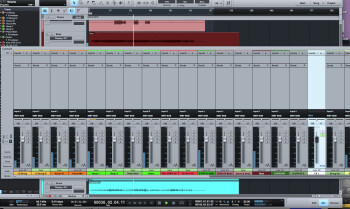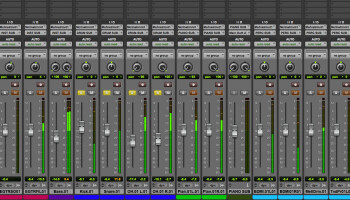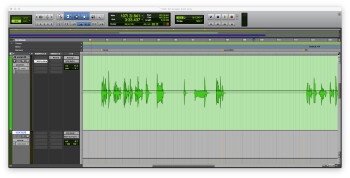Mixing a song offers a cornucopia of creative choices. You decide how loud to make every instrument, where to place it in the stereo image, which effects to use, which tracks to mute, and so forth. In fact, there are so many options that it can be overwhelming for a novice mixer. One of the first decisions you’ll run up against is, what to work on first? As you’ll see in this article, there are a number of different ways to get your mix going. Which one is best for you?
First, get organized
Before getting into actual mix workflows, let’s talk a little about track organization. Before you start moving faders, it’s very helpful organize the tracks in a logical manner, especially if it’s a large session. If you haven’t already, it’s easiest to color code your tracks so that different instrument and vocal categories have their own color, and to physically move the tracks so that in your DAWs console, all the drum tracks are together, all the guitars together, all the vocals are together and so forth. I always like to create subgroup faders for vocals, instruments, drums, and percussion. so that I can adjust those major groups of elements easily vis a vis each other.
You’ll probably also want to take this opportunity to add a couple of reverbs (one short, one long) and a delay, as initial bus effects, because you’re likely going to need them. Audiofanzine has covered mix organization topics in more depth in previous articles, here and here.
All zeroed out
Probably the most commonly used workflow is to start with your DAW’s console “zeroed out.” That means set all faders to 0 dB, set all your panners to center. Turn down or mute all sends, remove or bypass all inserts, and basically just start with a clean slate. The advantage to doing a “reset” as it were, is that the mix is now as close to a blank slate as it can be, considering that the tracks have already been recorded. Every move you make in the mix from here on out will be deliberately done, and there won’t be anything inadvertently EQed, unknowingly sent to a reverb, or panned in a funny way. In other words, you’re in control, because you’re starting from scratch.
If somebody were to send you tracks to mix, this is how you’d start anyway, because you’d be loading those tracks into a new session or new session template, but if it’s a project you’ve been working on, you will already have a rough mix of sorts happening. Which brings us to workflow number two.
Mix as you go
If you’ve been working on a project from its inception, and doing all or most of the tracking in your DAW, you might not want to reset your console before mixing. Most likely you’ve been adjusting levels, adding effects, and panning elements during the whole tracking and overdub process. Whether you realize it or not, you’ve been developing a rough mix. Sometimes rough mixes have an energy that’s hard to recreate when starting from scratch. So instead of starting from a clean slate, you keep what you have, and build on that.
Don’t touch that pan pot
So let’s say you go with the “all zeroed out” method, starting your mix from a blank slate, what next? One way to go, which I’ve found to be pretty effective, is to start the actual mixing by getting a balance of the instruments using volume faders and EQ only. Don’t touch the pan pots, and don’t add any effects. This will force you to really pay attention to the volume relationships between the tracks (make sure to check your gain staging at this point).
Once you have a good sounding foundation, then start to pan tracks and add effects, and you’ll hear your mix come to life. Some advocate a slightly different version of this method, in which you use volume and panning, but no effects in the first stage. This method was advocated by Nantho, the author of our ongoing series, “A Guide to Mixing Music.”
Drums First
Another common strategy for a mix done from scratch is to start with the drums, get them sounding good. Then add the bass, making it work well in relation to the drums, then add guitar or another rhythm section instrument and build your way up from there. Grammy winning engineer Darrell Thorp spoke to this in our recent interview with him: “I start with drums, bass, then get some guitars in or some sort of more melodic thing, ” he said, “and right about the time I do that, I start putting the vocals in, as well. And then start building up stuff around the vocals.”
Those who don’t build their mixes up like that, would argue that thecontext of the rest of the tracks is essential, but to me, if you can get the drums sounding good on their own, they’re going to sound good with the rest of the instruments, too, and you can always change EQ settings if necessary later.
When we interviewed Alan Parsons, he offered this twist on the “drums first” method. “I will start with the drums, but then I’ll take the drums out and look at everything else. And I like to get a balance of all the rhythm instruments, and even the sweetening instruments, the orchestra or whatever. I like to get that all feeling good without the drums, and then you bring the drums in and it suddenly becomes a record.”
Focus on the prime element
Another way to approach the beginning of the mix is to focus first on the most important element, which in most music will be the vocal. The theory is that since it’s the focal point of the mix, everything should flow outward from it. You could first get a quick balance of the other elements, just to give yourself a little context. But then, concentrate on getting that vocal (or other main element) sounding as good as possible. EQ, compress, add effects to it, whatever you need, but make it sound killer. Solo it at least some of the time, as you’re working, but also listen with the tracks.
Once you’ve got it sounding great, then fit the rest of the instruments or vocals in around it. The reason it’s important to focus on it early, is because if you don’t, you might make choices with how you treat that prime element that are a consequence of other choices you made while working on other instruments. Other than at the beginning of a mix, mixing decisions are reactive, that is to say that every move you make is based on the moves you made previously. That’s why it makes sense to focus most of your attention on the prime element, first.
So how do you choose?
As you can see, there many different ways to approach the beginning of a mix. That’s because mixing offers you so many options, and there is no “right way” to do it. So how do you decide what will work best for you? Try the different approaches described here (or any others you might hear about), and see what feels best, and what yields the best results.
As a novice mixer, it’s helpful for you to think about the approach you’re using as as you’re mixing, because doing so will help you be systematic about the whole process. Otherwise, it could become a pretty random exercise — just turning knobs and following wherever that takes you. Even if you ended up with a great result, you probably couldn’t repeat it on a different song because you weren’t following a system of any sort. Keeping the big picture in mind will help you gain control over of the crazy, wild, confusing, challenging, and amazing world of mixing.




